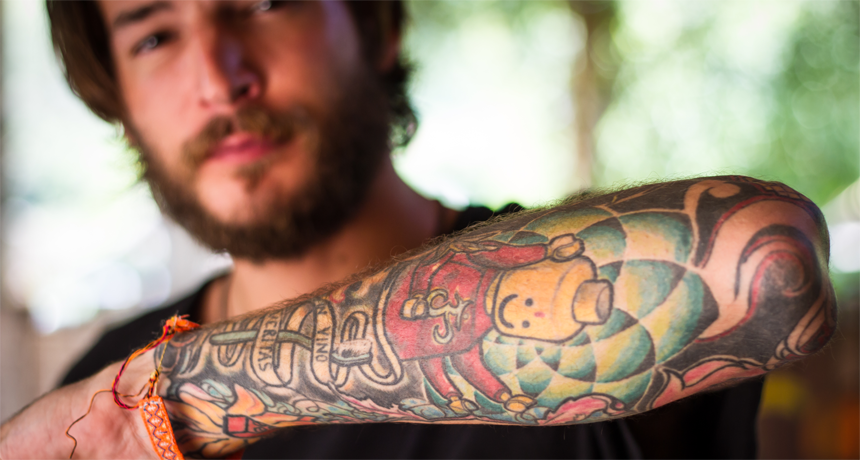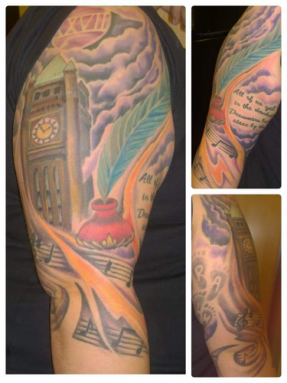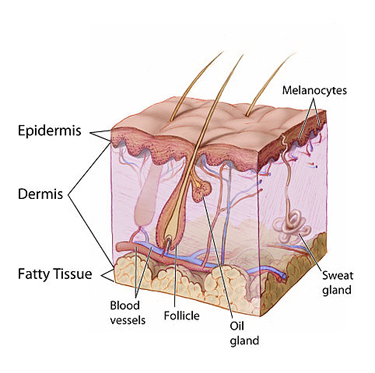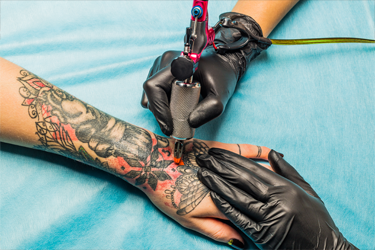Tattoos: The good, the bad and the bumpy
Tattoos can cause allergies — or they can prime the immune system

Many people use their bodies as an artistic canvas for permanently inked drawings. But the colored pigments in them were not developed for use in tattoos and may cause harmful reactions in some people.
mabe123/iStockphoto
Annabelle Townsend of Maple Grove, Minn. celebrated her eighteenth birthday with a trip to the tattoo shop. It was not a spontaneous decision.
“I designed the entire thing over a few years,” she says of the three-quarter sleeve that now adorns her right arm. (A tattoo sleeve, like the sleeve of a shirt, covers the arm.) “I drew it over and over until I had perfected it.” Townsend wanted the tattoo to be a collection of many things that were meaningful to her. “Every component was picked for a reason,” she says, including Big Ben, musical notes and one of her favorite quotes.

Turning her design into body art took a major commitment of both time and money. “It took four sessions — 13 hours total — over a few years to completely finish it,” she says. That’s because her arm needed time to heal between sessions. All those hours in the tattoo shop also didn’t come cheap. She saved up for years to pay for her sleeve.
Townsend is one of many young adults sporting inked body art. Researchers estimate that about four in every 10 young adults aged 18 to 29 have at least one tattoo. More than half of them have two or more. As tattoos have become more common, scientists have begun to study their health impacts.
This body art might appear cool, but it can pose risks. Some people react badly to the inks — substances that aren’t meant to go on or in the body. Other people may have trouble getting certain medical tests after a tattoo. And not everyone is as thoughtful as Annabelle Townsend when selecting their design. Many people get inked on a whim — and later want that permanent art removed. It can be done, but it’s a long and painful process.
Still, research now indicates tattoos aren’t bad for everyone. In people who heal well, getting a tattoo may prime their germ-fighting immune systems for action — and in a good way. The rub: Until someone gets a tattoo, there’s no way to know if they will be someone who benefits or instead be harmed.
If you hate getting shots, then tattoos aren’t for you. When a person gets a tattoo, a needle injects ink into the skin, over and over and over again.

When a tattoo is done right, that ink winds up in the dermis. This layer of skin lies beneath the epidermis, the outer layer that we see. The epidermis is always growing new skin cells and shedding old ones. If tattoo ink were placed there, it would last only about a month before disappearing.
But cells of the dermis don’t replace themselves in the same way. That’s what makes this thick layer of skin the ideal spot for installing a permanent image. The dermis also is home to nerve endings, so you can feel each needle prick. Ouch! Finally, this part of the skin receives the area’s blood supply. So things can get messy as ink is injected into the dermis.
Normally, the body’s immune cells would react to being pricked and injected with ink. After all, getting a tattoo means putting foreign particles in the body. The immune system should respond by removing them — or at least trying to. But the molecules of tattoo ink are too big for those cells to deal with. That’s what makes a tattoo a permanent piece of body art.
Inky issues
Organic chemicals contain carbon. Inorganic ones don’t. The inks used for tattoos can be either inorganic or organic, notes Tina Alster. She’s a dermatologist, or skin specialist, at Georgetown University Medical Center in Washington, D.C. She also directs the Washington Institute of Dermatologic Laser Surgery. Inorganic inks are made of minerals, salts or the metal oxides found in nature. (Metal oxides are molecules that contain metal atoms and oxygen atoms.) Inorganic inks can be black, red, yellow, white or blue. Organic colors contain lots of carbon and hydrogen atoms. The ones used in tattoo ink are synthetic, meaning manufactured. Organic inks come in a much wider array of colors than do the inorganic ones.

Tattoo inks are made to be injected into the skin. But the pigments that give these inks their color were made for printer inks or car paints — not people, Alster explains. The Food and Drug Administration, or FDA, makes rules about what kinds of colors can be added to food, cosmetics and drugs. Although FDA could regulate tattoo inks, it hasn’t done so yet. So no ink is currently approved for use in human skin, Alster notes.
That may change, however. FDA currently is studying the health effects of tattoo inks. The reason? More and more people have been reporting harmful reactions to them. Some tattoos make a person’s skin tender and itchy. This usually is due to an allergic reaction to some ingredient in colored inks, such as chromium or cobalt, Alster says. Red and yellow inks are most likely to cause such reactions, she says. But green and blue can cause reactions, too.
In some people, the skin around a tattoo may gets bumpy or scaly. “This is also due to inflammation and irritation [in response] to the tattoo inks,” Alster says. Inflammation is the pain, swelling and redness that can accompany an injury. It “may even indicate infection,” she points out.
And these reactions aren’t the only problems that can arise from a tattoo. Those created with metal inks can interfere with an MRI scan. Short for magnetic resonance imaging, doctors use these scans to look inside the body. The strong magnet in the MRI machine can heat the metal in the tattoo ink. Although it’s not usually a problem, such heating can sometimes cause burns. Tattoos also can distort the image created by the machine. That’s not to say people with tattoos should avoid MRIs if their doctors say they need them. But they do need to tell their doctors about any tattoos.
Priming the immune system
Those are some of the risks that inking the body can cause. More recently, research also has uncovered some good news. Most people don’t experience any problems from a tattoo. And in them, getting inked body art may confer health benefits. The inking process may actually turn on the immune system, helping to keep such individuals healthy.
That’s the finding of a study by Christopher Lynn and his team at the University of Alabama in Tuscaloosa. Lynn is an anthropologist, someone who studies the social habits of people. He was interested in the idea that tattoos might signal someone’s good health to others.

It’s true that most people heal smoothly. Still, getting a tattoo is stressful, he notes. And it can be dangerous: People can get infections from unclean equipment. They can suffer allergic reactions. And in cultures that use traditional tools to create large tattoos, the pain and stress has occasionally even led to death. “Historically and cross-culturally,” Lynn says, “peoples have referred to tattooing as toughening the body up or ‘hardening’ it.”
People living in areas where infectious disease is a big threat are most likely to have ritual tattooing, Lynn notes. These cultures view tattoos as “almost an advertisement” of good health, he adds. To find out whether tattoos really do signal good health, he and his team looked at stress and immune responses in people who got tattoos.
The researchers recruited 29 people who were planning to get a tattoo. Before the inking started, each person put a swab under his or her tongue for up to two minutes. The saliva-soaked swab then went into a collection tube. It would be analyzed later. Each person repeated that saliva collection after getting the tattoo.
Lynn’s group then analyzed the saliva samples for cortisol. It’s a hormone. The body makes more of it when someone becomes stressed. No surprise: Everyone had an increase in cortisol after a tattoo. Getting this body art is, after all, stressful. But cortisol went up less in people “with lots of tat experience,” Lynn found.
The researchers also looked for levels of an immune protein called IgA. It’s short for immunoglobulin A (Ih-MU-no-glob-yu-lin A). IgA is an important defender against germs, Lynn notes, such as the virus that causes the common cold. The IgA protein is found in the digestive tract and the body’s upper airways. Its job is to glom onto germs and other materials the body wants to get rid of. IgA’s presence flags such invaders so that the body’s immune cells know to track them down.
When people are stressed, cortisol lowers their immunity, Lynn explains. He suspected the stress of getting a tattoo might show up in IgA levels. And that’s precisely what he and his team found: IgA levels fell after getting a tattoo. This was especially true in people who were getting their first tattoo.
People who already had tattoos experienced less of a drop in their IgA levels. Levels of the protein also returned to normal faster. Those with many tattoos showed the smallest change.
“The body actually adjusts to getting tattoos for people who have a lot [of them],” Lynn explains. In these people, IgA dips only slightly during the process of tattooing. That means their bodies can start to heal more quickly, he explains. His team call this quick recovery a “priming” of the immune system. In other words, Lynn explains, a tattoo gets the immune system ready to face other challenges.
“Usually, with the stress response, there’s a lull while the immune system kicks in,” he says. “We think tattooing turns on the immune system in a way that has it ready to go without the lull.”
Does that priming carry over to other areas of health — such as helping people fight infections? Lynn doesn’t yet know. “I think it would go beyond the tattoo experience,” he says. The stress response is very general, he notes. “So it basically [tells] the system to be vigilant.”
Some heavily tattooed people claim to be resistant to colds and to heal quickly from minor injuries. Such reports are anecdotal, or individual stories not yet shown to be typical or reliable. But such claims have prompted Lynn to start a new scientific study. It will seek to check out whether such benefits extend beyond the tattoo shop.
Not-so-permanent art
It used to be that people who got tattoos had them for life. Removing them was possible but required painful methods, such as rubbing off the outer layers of skin with salt or a wire brush. Now, dermatologists have turned to lasers for tattoo removal. The process actually has become common in the past 30 years.
That’s good news for people who got their tats in a spontaneous mood — or who now want to remove the name of an ex-girlfriend or ex-boyfriend.
Story continues below image.

To remove tattoos, doctors direct very short bursts of laser energy at an inked image. Each burst lasts only a nanosecond (one billionth of a second). Such short bursts of light are much higher in energy than a laser that beams its light continuously. That high energy can damage nearby cells. Yet doctors need such high energy bursts to break apart particles of tattoo ink. Keeping each zap of laser light extremely short seems to break up the tattoo ink while doing minimal damage to the skin.
“We use a laser with two different wavelengths [of light],” says Heather Swenson. She is the co-owner of Revitalift Aesthetic Center in Lincoln, Neb. Different wavelengths work better at destroying different colors of ink, she explains.
Short-wavelength light works best at breaking up red, orange and brown pigments. Longer wavelengths can be used for greens, blues and purples. Any wavelength of light will break up black pigment. That’s because black absorbs all colors of light.
“The tiny particles [of ink] are taken away by the lymphatic system,” Swenson says. It’s a network of vessels that helps the body rid itself of unwanted materials.
Removing a tattoo takes time. Four to eight treatments is typical, she says. A person might need even more to remove large tattoos or those with many colors. Sessions are usually one or two months apart. That gives the skin time to heal between sessions. They’re not cheap, either. Each session may cost at least $150, Swenson notes. But they are effective. About 95 percent of a tattoo can be removed, she says. “Most people say they can’t even see them when we are done.”
Just because the technology exists to remove tattoos doesn’t you should run out and get one, though.
“Don’t get a tattoo impulsively,” Lynn advises. Don’t get one “under the influence of anything,” he adds, “or from someone whose work you don’t know.”
Alster also cautions people to choose a tattoo artist carefully. “Be wary of who is performing the tattoo, the facility where the tattoo is being applied, and what tattoo inks are being injected,” she says. “While tattoo parlors are licensed as businesses, they are not regulated for safety.”
Townsend agrees. “You get what you pay for,” she says. “To me, if you’re going to have someone’s art forever on your body, you’d better make sure it’s going to look good! Find a tattoo artist whose style you like and who will be honest with you” about how your planned design will turn out, she adds.
“The hardest part is coming up with a design that is meaningful,” Lynn says. You should find one that “will stay meaningful to you, and that the artist can execute well.” Annabelle Townsend’s tattoo, which she spent years planning, is a perfect example.
“Every tattoo has a story,” Lynn says, “but it’s worth the trouble for the story you tell to be a good experience that you’re proud of, not one you wish you could cover up.”







